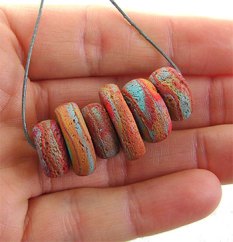Southwest mysteries


The southwest influence is clear in these mixed media art dolls from Albuquerque artists Mary and Doug. I wish I could tell you more. We’ll have to wait for information to seep in through the back channels. Susan Lomuto pinned the link on her board first.
The doll bodies are made of various fabrics with stylized and painted polymer heads. They stand 15″ tall. There’s a whole Etsy gallery of interesting designs!
More mystery
If your first efforts in polymer are discouraging, you may want to click on the photo below to see who started out making basic beginner beads just like everyone else. His beads have improved considerably. See what happens when you keep trying?













